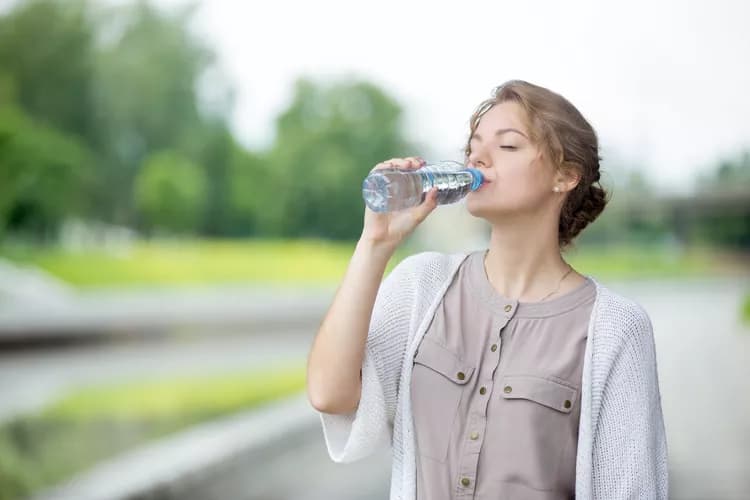
Drinking An Ice Slurry/Water Mix Helps Body Cope With Exertion In Hot Weather
New research from the University of Montana demonstrates a unique relationship between fluid volume and fluid temperature during arduous work in the heat. The study, published in Wilderness & Environmental Medicine, indicated that an ice slurry/water mixture was as effective as ambient water even when consumed in half the quantity. Investigators also emphasized the importance of rest.
"While the common approach to managing health in hot environments centers around maintaining hydration, limited attention is devoted to managing heat production from hard work or play," explained lead investigator Brent C. Ruby, PhD, FACSM, Director of the Montana Center for Work Physiology and Exercise Metabolism, University of Montana, Missoula. "It should be obvious that as the temperature rises, so does the body's need for proper fluid intake patterns. This ensures that blood and sweat volume can be maintained to continually enable heat loss through evaporative cooling (good old fashioned sweating). However, coaches, trainers, clinicians, medics, and safety officers continually emphasize the importance of proper hydration without providing sound guidance and attention to proper management of heat production from the working muscle. "
Existing research indicates that fluids should be consumed to avoid more than an acute 2% body mass loss (reflecting modest dehydration) that is known to hinder performance and increase the risk of heat-related injury. Currently, the accepted minimum hydration rate is 2 grams of water per kilogram of body mass. However, controversy surrounds the link between moderate lapses in hydration status and risk for heat-related injury.
While these guidelines attempt to dictate how much water should be consumed, there is no existing recommendation for the optimal temperature of the water. In order to better understand how water temperature influences the body, investigators had subjects exercise in 88° F air temperatures (with 50% relative humidity) for three hours.
"While these guidelines serve as just that, 'guidelines,' constant access to body weight scales for repeated measures of nude body weight is impractical for nearly all sport or occupational settings. Reducing the emphasis on fluid volume, allowing cold fluid access, and emphasizing the need to rest adequately during the training session or workshift should become common practice," stated Dr. Ruby.
During the trial, participants were randomly given one of three treatments: ambient temperature water at a rate of 2g·kg-1 of body mass; ice slurry (2/3 shaved ice and 1/3 water) at a rate of 2g·kg-1 of body mass; or the ice slurry mixture, but at a reduced rate of 1g·kg-1 of body mass. Each 2g·kg-1 body weight drink was provided at 10-minute intervals.
Several parameters indicating the physiological and thermoregulatory challenge during the three-hour exercise trials were measured. Investigators found the ice slurry, even at amounts that resulted in a 2% body mass loss, faired just as well as when subjects were provided the full amount of room temperature water. "There were no differences in rectal temperature, heart rate, physiological strain index, skin temperature, sweat loss, or rating of perceived exertion during three hours of exercise in the heat when participants were provided half the volume of fluid in the form of the ice slurry in comparison to ambient temperature water," said Dr. Ruby.
While a reduced amount of ice slurry was just as effective as regular water, when the ice slurry was provided at the full rate, participants demonstrated significantly improved thermoregulation. Rectal and skin temperatures, heart rate, and overall all physiological strain were lower at the end of the exercise period, making the full amount of ice slurry the most effective liquid for managing thermoregulation and physiological responses.
"We want to emphasize that the temperature of fluids delivered will alter the physiological and thermoregulatory response during work in the heat. Consuming ambient temperature water did not improve the physiological or thermoregulatory responses compared to the one-half volume ice slurry/water mixture," noted Dr. Ruby.
Previous studies have pointed to cold water as being a more effective method of hydration, but this new information reveals that temperature may be as important as volume. This means that people exercising or working in very hot conditions may be able to carry and drink less water if they are able to keep it ice cold. "Military training and operations, wildland fire suppression, and varied athletic/recreational pursuits require people to work or exercise in hot environments for extended periods of time. These activities also mandate the self-transport or frequent resupply of fluid to sustain performance for the duration of the work shift or event," added Dr. Ruby. "For these individuals the weight of fluid that must be carried increases the metabolic demand and subsequent heat production, posing hindrances to completing the job or event."
As more people become active outdoors and with temperatures on the rise, it is vital that we figure out the most effective ways to manage heat stress and remain safe in all conditions. This new study reveals that consuming an ice slurry mixture may offer protective effects against heat stress. "Individuals working in hot environments should be mindful of both the volume and temperature of the fluid they consume," concluded Dr. Ruby. "Further research should be done to determine impact that exchanging fluid temperature for fluid volume has on exercise performance."
Materials provided by Elsevier. Note: Content may be edited for style and length.
Disclaimer: DoveMed is not responsible for the adapted accuracy of news releases posted to DoveMed by contributing universities and institutions.
Primary Resource:
Hailes, W. S., Cuddy, J. S., Cochrane, K., & Ruby, B. C. (2016). Thermoregulation During Extended Exercise in the Heat: Comparisons of Fluid Volume and Temperature. Wilderness & Environmental Medicine, 27(3), 386-392.
Related Articles
Test Your Knowledge
Asked by users
Related Centers
Related Specialties
Related Physicians
Related Procedures
Related Resources
Join DoveHubs
and connect with fellow professionals

0 Comments
Please log in to post a comment.